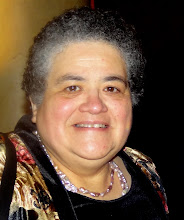 Central Falls High School teacher Deloris Grant - Providence Journal/Connie Grosch
Central Falls High School teacher Deloris Grant - Providence Journal/Connie Grosch
The discussion about the firing of the teachers at Central Falls has been framed in terms of greedy teachers facing down School Superintendent Frances Gallo who is facing the demands of the new State Education Commissioner Deborah A. Gist. The superintendent threatened; there were negotiations; then threats; the union conferred and rejected the superintendent's demands. The superintendent then fired all the teachers.
Missing from the discussion is the effect of firing teachers who have been working under nearly combat conditions for a very long time. Essentially, these teachers have been overworked for a long, long time, and their mass firing is their reward for trying to do their best and for seeking the protection of collective bargaining.
You know, everybody has something critical to say about these poor teachers but my sympathies are with them.
People think that teaching high school kids is like selling flowers for eight hours a day. It isn't. It is difficult, exhausting, exasperating work, especially in schools that serve impoverished populations. People don't take into consideration that good teachers never get time off. They finish their teaching then face parent-teacher conferences, detention supervision, library supervision, club supervisions, choral practice; debate practice, tutoring: It's always something. Then they go home, have dinner with their own kids and start grading papers and preparing for classes for the next day; then they work their entire weekends as well.
Nobody expects a secretary to provide her own paper and printer toner but teachers end up purchasing a lot of their own materials out of their own pockets. That's why Office Max and Staples have discount programs for teachers.
In addition to teaching, they have to maintain discipline which is hard enough under the best circumstances; even I have to be on top of my game every day to maintain classroom discipline, and I teach college students. The teachers at Central Falls are dealing with students, over 90% of whom are living in poverty, who may receive their only substantial meals at school; who have parents who are working at jobs that don't pay enough to support their families--IF THEY'RE LUCKY and aren't unemployed or drug addicted or alcoholic or heaven knows what else. 90% of the kids at Central Falls High School fall under the poverty line. The majority of those parents are immigrants, with few English skills. Many of the kids are involved in gangs. It's not that the parents don't care but often they come from cultures where the teachers were the educated ones, and the parents didn't intervene unless the teachers called them in because the kids were discipline problems. In America, there is the middle-class culture of the PTA and parental involvement in everything. Not all cultures have middle-class with parents in the middle of everything; one cannot assume that their non-involvement reflects a lack of caring.
 CFHS Librarian Sandy Fisher - The Providence Journal/Steve Szydlowski
CFHS Librarian Sandy Fisher - The Providence Journal/Steve Szydlowski
The letters to the editor paint the teachers as greedy and call them every manner of name. They should try teaching in an inner city school for a week and see if they come out with their sanity intact.
I taught middle school (6-7-8th grades) for one year, in a Catholic school back in 1974-75; I was twenty-three at the time. Because it was a Catholic school in a Latino neighborhood, I had virtually no discipline problems. Nevertheless, by the time my work day ended—teaching, supervising the lunch room; watching the play in the schoolyard after school—I used to drive home and fall into bed and sleep for three hours before I could make dinner and prepare for my next day's classes.
Years later when I considered going to graduate school, I did not entertain the idea of teaching high school for more than a minute. It is all I can do to keep myself from asking the students I teach who are preparing to be teachers, if they have any idea what they are getting into. Do they know that they will be blamed for poor test scores, disruptive students; students who do not do well because they are working nights or they are running with gangs? Or because they are hungry? Or because they have no place to study because they are sharing a room with several siblings and perhaps bear heavy child care responsibilities for their younger siblings?
I understand that superintendents have to do something; they have to find solutions or at least look like they are looking for solutions. I know that not all teachers are excellent; some are bad and others are downright cruel. I do not have any solutions but I do have a deep sense of the injustice being perpetrated on the teachers they are firing en masse in Central Falls.
Teachers are among the most maligned groups in our society. Because educating children costs so much, the public resents having to pay the bill, and teachers, particularly those who are unionized, are attacked because their collective bargaining agreements guarantee fair pay and benefits.
It is a hard, hard job. You couldn’t pay me enough to do it, and most people could not do it.




